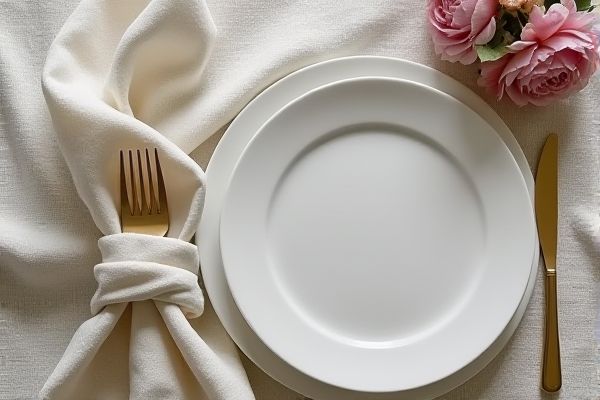
Linen napkins offer a luxurious texture and superior durability, making them ideal for elegant dining experiences, while cotton napkins provide softness, affordability, and ease of care for everyday use. Discover the key differences and decide which option best suits Your needs in the rest of this article.
Table of Comparison
| Feature | Linen Napkin | Cotton Napkin |
|---|---|---|
| Material | Made from flax fibers | Made from cotton fibers |
| Durability | Highly durable, strengthens when wet | Moderately durable, prone to wear over time |
| Absorbency | Highly absorbent | Good absorbency |
| Texture | Smooth, slightly crisp | Soft and flexible |
| Maintenance | Requires careful washing, may wrinkle easily | Easy to wash and maintain, less prone to wrinkles |
| Drying Time | Dries quickly | Slower drying |
| Cost | Generally more expensive | Usually affordable |
| Environmental Impact | Eco-friendly, biodegradable, less water-intensive | Biodegradable but may require more resources |
Introduction to Linen and Cotton Napkins
Linen napkins, made from flax fibers, offer natural durability, high absorbency, and a crisp texture that improves with washing, making them ideal for elegant table settings. Cotton napkins are softer and more affordable, featuring excellent absorbency and easy care, suitable for everyday use or casual dining. Choosing between linen and cotton napkins affects your dining experience, balancing sophistication and practicality according to your needs.
Material Composition and Texture
Linen napkins are made from flax fibers, offering a crisp texture that softens with use and washing, while cotton napkins consist of cotton fibers known for their soft, absorbent qualities right from the start. Linen's natural stiffness and subtle luster provide an elegant, textured feel, whereas cotton napkins feature a smoother, more uniform surface ideal for everyday use. Both materials are breathable and durable, but linen napkins tend to have a slightly coarser hand, making them popular for formal dining settings.
Absorbency and Functionality
Linen napkins exhibit superior absorbency due to their natural fiber structure, allowing them to quickly soak up spills and moisture, making them highly effective for dining purposes. Cotton napkins, while also absorbent, tend to retain moisture longer, which can cause them to feel damp and less functional in fast-paced dining settings. Both materials offer durability, but linen's faster drying time enhances overall functionality by reducing the risk of bacterial growth and odors.
Durability and Lifespan
Linen napkins offer superior durability compared to cotton napkins due to their strong flax fibers, allowing them to withstand frequent washing and maintain their shape over time. Cotton napkins, while soft and absorbent, tend to wear out faster, developing holes or thinning with extended use. Choosing linen napkins ensures a longer lifespan for your table linens, making them a more sustainable and cost-effective option.
Maintenance and Care Requirements
Linen napkins require gentle washing with mild detergents and line drying to maintain their texture and longevity, as high heat can cause fiber shrinkage. Cotton napkins are more durable under frequent machine washing and can withstand higher temperatures, making them easier to sanitize and maintain. Both materials benefit from prompt stain treatment, but linen demands more delicate handling to preserve its natural fibers and prevent damage.
Environmental Impact and Sustainability
Linen napkins have a lower environmental impact than cotton napkins due to their production from flax, a crop requiring less water, pesticides, and fertilizers. Linen fibers are biodegradable and more durable, extending the lifespan of your napkins and reducing waste. Choosing linen over cotton supports sustainability efforts by minimizing resource consumption and promoting eco-friendly textile options.
Cost Comparison
Linen napkins generally cost more than cotton napkins due to the labor-intensive cultivation and processing of flax fibers combined with their durability and luxurious texture. Cotton napkins offer a more budget-friendly option, with lower raw material and manufacturing expenses, making them suitable for everyday use or large-scale events. The initial higher investment in linen often balances out over time because of its longer lifespan and resistance to wear compared to cotton.
Aesthetic Appeal and Style Options
Linen napkins offer a natural texture and elegant drape that enhances a sophisticated table setting, while cotton napkins provide a softer feel with a wide variety of colors and patterns to suit casual or formal occasions. The crisp, slightly textured finish of linen adds a timeless, rustic charm, whereas cotton napkins allow greater versatility in design, making them ideal for personalized or vibrant styles. Choosing linen or cotton napkins impacts the overall aesthetic appeal and style options available, letting you tailor your table decor to match the desired ambiance.
Best Uses and Occasions
Linen napkins excel in formal dining settings and special occasions due to their elegant texture and natural luster, making them ideal for weddings, holiday dinners, and upscale restaurants. Cotton napkins offer versatility and durability suited for everyday use, casual meals, and outdoor gatherings, as they are easy to wash and maintain. Both fabrics provide absorbency and comfort but differ in texture and maintenance, influencing their best use scenarios.
Final Verdict: Which Napkin Is Right for You?
Linen napkins offer superior absorbency, durability, and a natural texture ideal for formal dining, while cotton napkins provide soft comfort, ease of care, and affordability better suited for everyday use. Consider factors like laundering frequency, fabric feel, and desired aesthetic when choosing between linen and cotton. The right napkin ultimately depends on your specific needs for usability, appearance, and maintenance.
 homyna.com
homyna.com